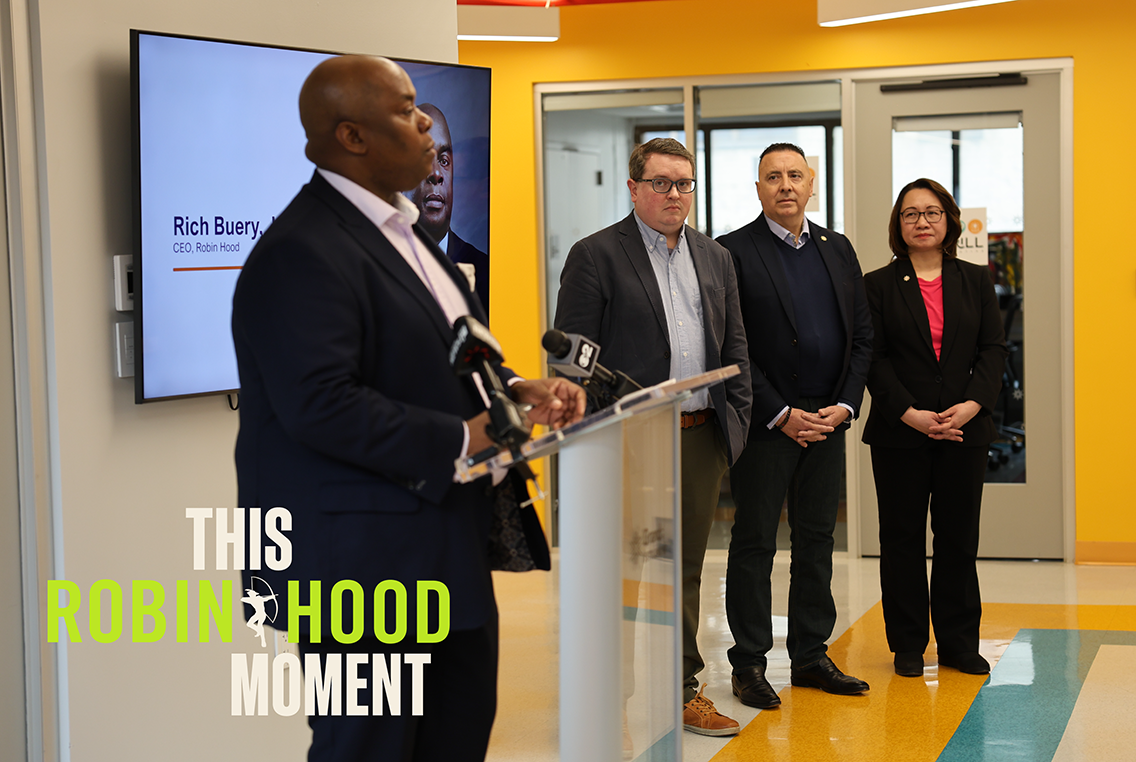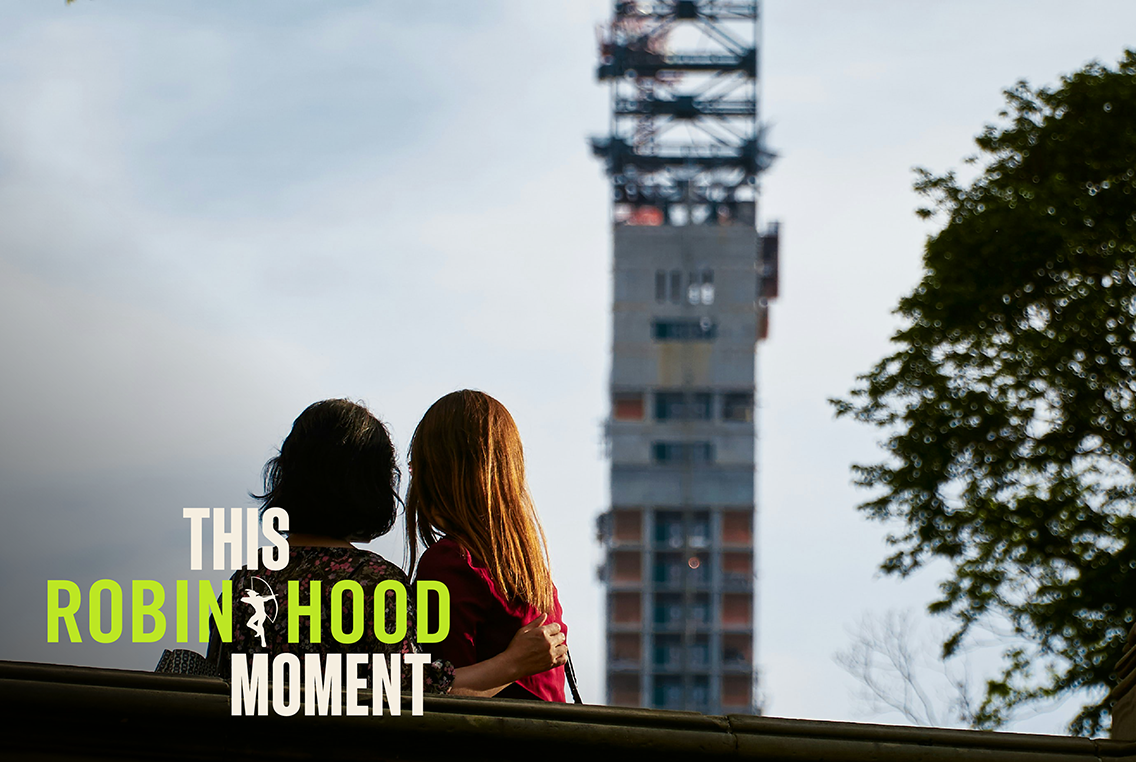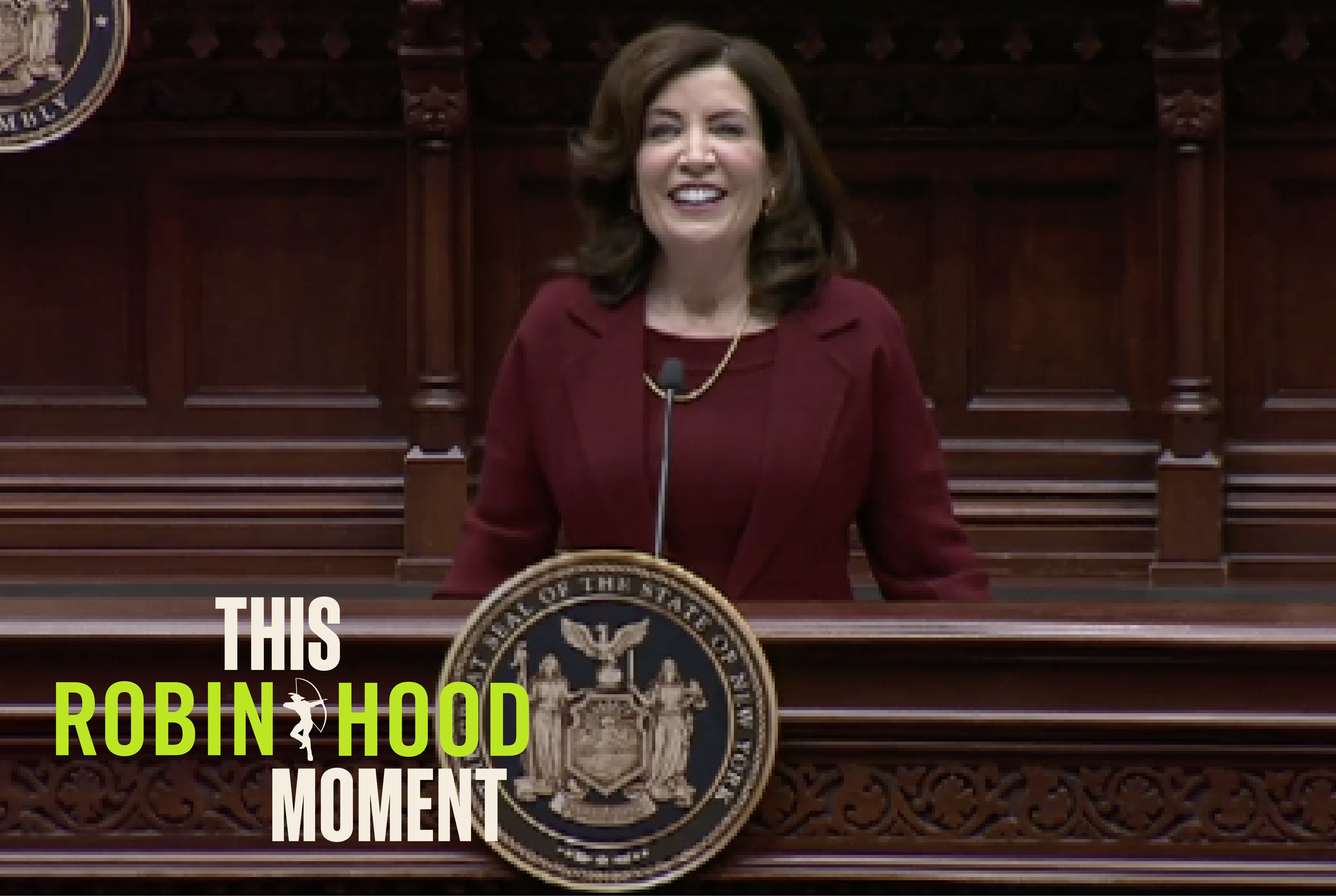Apr 10, 2024
Addressing NYC’s Poverty Surge: Insights from the Poverty Tracker (Pt 1) | This Robin Hood Moment
Robin Hood's latest Poverty Tracker Annual Report, jointly released by Robin Hood and Columbia University’s Center on Poverty and Social Policy, revealed a historic spike in poverty rates across New York City, with an additional 2 million residents plunging into poverty between 2021 and 2022 alone. Join our hosts Crystal Cooper and Kevin Thompson as they unpack the factors contributing to this alarming trend, and offer insights from Robin Hood CEO Richard R. Buery, Jr., Columbia CPSP Director Christopher Wimer, and Robin Hood grantee Grand Street Settlement CEO Robert Cordero.
Listen and Subscribe: Amazon Music | Apple Podcasts | Spotify | YouTube
Listen to Part 2 of our podcast on the 2024 Annual Poverty Tracker from later in the season.
Learn more about Robin Hood’s 2024 Annual Poverty Tracker.
To learn more about the Columbia University Center for Poverty and Social Policy, visit their website.
To learn more about Grand Street Settlement, visit their website.
Read the New York Times article by Stefanos Chen on the findings of the 2024 Annual Poverty Tracker.
Thoughts? Guest suggestions? Email us at info@robinhood.org.
“This Robin Hood Moment” is produced by Cory Winter; graphics are produced by Mary Power; visuals are provided by Motion Array; music and sound are provided by Epidemic Sound. Special thanks to Richard Buery, Christopher Wimer, and Robert Cordero.
The views and opinions expressed by external podcast speakers and guests are solely their own and do not reflect the opinions of Robin Hood or its personnel, nor does Robin Hood advocate or endorse any individuals or entities featured on the episodes.
TRANSCRIPT
This transcript was prepared by a transcription service. This version may not be in its final form and may be updated.
Crystal Cooper: Welcome to “This Robin Hood Moment.” We’re your hosts Crystal Cooper and Kevin Thompson.
Kevin Thompson: Today we’re discussing findings from our latest Poverty Tracker report: the sixth annual State of Poverty and Disadvantage in New York City. The Poverty Tracker is a collaboration between Robin Hood and Columbia University’s Center on Poverty and Social Policy, produced since 2012. It is a statistically valid survey that captures the fluid nature of poverty, following a group of families and individuals, several times throughout the year, and that makes it a tool for monitoring poverty and well-being across New York City. Giving Robin Hood experts the data they need to make grants and advocate for smart policies that can ultimately elevate our neighbors out of poverty. Crystal what’s in this year’s report? Help us understand the current landscape.
Crystal Cooper: Well, Kevin. The findings are so significant that the New York Times gave it a front-page headline, so there you go. The story here is pretty alarming: The 2024 Poverty Tracker documents the largest single-year increase in poverty in ten years, dating back to when we launched the study. There were 2 million New Yorkers living in poverty in 2022, up from 1.5 million the year before. And that puts the city’s overall poverty rate at 23%. And Kevin, the stat that seems to startle most people, 1 in 4 children live in poverty, and that is 25% of all New Yorkers under 18, fully a quarter of the population of children in New York City are in families that can’t afford a basic standard of living. And just as a reminder, for families of four, the poverty line is around $44,000 per year in income.
Kevin Thompson: Wow. That is quite troubling.
Crystal Cooper: It is, Kevin. This is big news, and I just want to put the child poverty rate into a national perspective. So, the U.S. child poverty rate is 12%, and here in New York City, we’re double that and then some. And one final thing I’ll add is that this year’s report includes a special spotlight on the city’s affordability crisis, and what it finds is that more than half of the city’s population, so 4.6 million people, are living below 200% of the poverty line. And that translates to half of the city’s population earning below around $88,000 per year for a family of four.
Kevin Thompson: I mean, because that just says that people are making… they’re faced with hard choices. They’re, you know, do I pay my rent this month or do I pay those utility bills and feed my family? Because clearly you can’t do both on that limited amount of income in New York City, which is one of the most expensive places in the United States to live. Let’s listen to what Rich Buery has to say about why these numbers are what they are right now?
Richard Buery: When we looked at the data from 2021, we hailed a temporary expansion of stabilizing programs like tax credits, increased SNAP benefits, and a local eviction moratorium for driving poverty rates to historic lows. As an example, the Temporary Expanded Federal Child Tax Credit reduced child poverty in New York City by more than 30% in 2021. The net effect of all government programs with a half a million children in the city were kept out of poverty this year. So, we saw during the pandemic, the government—City, State, and local and federal—were willing to make changes that kept New Yorkers thriving. However, the end of the pandemic era support combined with sharp increases in the cost of housing, energy, transportation, recreation and food, have caused us to return to pre-pandemic levels of poverty and hardship. It does not have to be this way. We know what policies work to keep people out of poverty, things like fully refundable tax credits, housing vouchers, and affordable child care can move millions out of poverty and hardship. We have the evidence. We also know that securing the proven effective solutions long term isn’t solely a matter of knowing what works. It’s a question of political will.
Kevin Thompson: Crystal, I think Rich captured what we believe wholeheartedly at Robin Hood, and know to be true, that policy fights poverty. Period. Right now, it’s budget season in Albany. And you know that the legislators and governor are negotiating how to spend the State’s billions of dollars. And at Robin Hood, you know, we believe that New York should invest in creating or expanding state versions of many of their historic policies and income supports that were implemented under the 2021 American Rescue Plan that helped keep so many people out of poverty during the height of the pandemic.
Crystal Cooper: That’s right, Kevin. Our Albany agenda for the FY25 budget includes so many of those policies like strengthening the State’s child tax credit program, creating a State-level version of a housing vouchers program to prevent homelessness, and also reforming the State’s temporary disability insurance rules so that working people can take the time they need to get well or to take care of their families without sacrificing much needed income. You know, actually Kevin, Chris Wimer who is the Director of the Center for Poverty and Social Policy at Columbia, spoke about how these exact supports offer stability to low-income families and those living below the poverty line.
Chris Wimer: The poverty rate of 23% is almost twice as large as the poverty rate in the U.S. as a whole, and that’s been true for quite a while, with some evidence that that gap between the city and the nation as a whole might be growing. There’s no magic line where all of a sudden, you know, life is perfect for every New Yorker. But, we argue that this is a line where, in our prior research, we’ve seen that people’s experiences of hardship begin to diminish, where people’s likelihood of falling back into poverty, if they’ve exited poverty, had their poverty begin to diminish. But we still find that 1 in 5 New Yorkers, reported living paycheck to paycheck in the past 12 months.
Kevin Thompson: That paints a real picture for people. Given what the data show about the sharp increases in poverty and hardship, we often look to the voice of our grantees—those direct service providers—to give us a reality check, breathing life into the numbers.
Crystal Cooper: Exactly. One of those long time grantee partners is Grand Street Settlement. So for those who don’t know, they are a traditional settlement house founded more than a century ago. And they have deep roots on the Lower East Side, which gives them real, on the ground experience, helping people navigate the many layers of poverty. They assist families with everything from child care to after school programing, meals for seniors, and they also help eligible New Yorkers sign up for the benefits that they’re entitled to that assist with the cost of living. Grand Street CEO Robert Cordero was particularly fired up about child care, having witnessed the affordability challenges that so many families who participate in his programs go through. So let’s listen to what he has to say.
Robert Cordero: The work that Columbia University and Robin Hood have done is highlighting a dire situation that most of our participants at Grand Street Settlement—18,000 families that we serve—face daily. I want to start off with a question: Is this the New York City that we want, where nearly where 1 in 4 New Yorkers is locked in poverty? I’ll cut to the chase. Child care costs are too damn high for our families. Only government has the ability and the resources to move New Yorkers from surviving to thriving.
Crystal Cooper: The more we learn, the more it’s sounding like the profile of poverty in this city looks like the classic Tale of Two Cities. That’s really concerning. So what else does the report tell us about disparities, particularly, how is poverty experienced differently between different groups of New Yorkers?
Kevin Thompson: Well Crystal, the Tale of Two Cities is a good analogy. Literally, this report reveals that Latino New Yorkers are twice as likely to live in poverty compared with white New Yorkers, 26% versus 13%. And the rates of poverty were similarly elevated among Asian and Black New Yorkers, 24% and 23%, respectively.
Crystal Cooper: So, what you’re saying is people of color experience disadvantage and more are living in poverty compared to their white counterparts, but I know it doesn’t stop there, disparities—
Kevin Thompson: Exactly! Female New Yorkers are experiencing higher rates of all forms of disadvantage when you compare them to male New Yorkers, and certainly New Yorkers who were born outside of the U.S. are also facing higher rates of poverty than those New Yorkers who were born here in this country. And the disparities persist even on a geographic scale within the city, where the highest concentrations of disadvantaged people living in poverty are in the Bronx.
Crystal Cooper: Our time is winding down here Kevin, but there’s a bigger story tell. At Robin Hood, the Poverty Tracker is our roadmap for all things grantmaking, advocacy and storytelling.
Kevin Thompson: And you can subscribe now for future chapters. Where we will go to the frontlines of poverty across all five boroughs. We’d love to have you join us.
Crystal Cooper: That was our episode on the Robin Hood Poverty Tracker Annual Report, and that’s it for ‘This Robin Hood Moment.’ Today’s show was produced by Cory Winter. Our graphics were produced by Mary Power. I’m Crystal Cooper joined by the insightful Kevin Thompson for Robin Hood—New York City’s largest poverty-fighting philanthropy. Thanks for listening.



